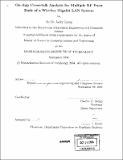On-chip cross-talk analysis for multiple RF front ends of a wireless gigabit LAN system
Author(s)
Liang, Jie De Jacky, 1977-
DownloadFull printable version (7.472Mb)
Other Contributors
Massachusetts Institute of Technology. Dept. of Electrical Engineering and Computer Science.
Advisor
Charles G. Sodini.
Terms of use
Metadata
Show full item recordAbstract
In the Wireless-Gigabit-Local-Area-Network (WiGLAN) project, we proposes a system architecture that adopts multiple antennas [1, 2, 3, 4] to control the trade-off between data rate and transmission quality [5, 6] through Space-Time Coding (STC) [7, 8, 9] and Orthogonal Frequency Division Multiplexing (OFDM). However, along the multiple RF front-ends, there are multiple nodes that signal cross-talk can occur. Such signal cross-talk occurring on a silicon chip becomes more and more significant as the integration level and operating radio frequency rise, seriously degrading the system performance, the data rate and transmission quality. Most of the literature about on-chip crosstalk suppression have been focusing on adopting various process-technology techniques, such as using guard ring structures to separate the parallel RF front ends or inserting a ground plane to shield the cross-talk. In this study, we will take a different approach. We will investigate the effects of on-chip cross-talk upon the operations of the coding and modulation schemes adopted in the WiGLAN system and explore methods, other than those mentioned, to counteract them.
Description
Thesis (S.M.)--Massachusetts Institute of Technology, Dept. of Electrical Engineering and Computer Science, 2004. Includes bibliographical references (leaves 169-173).
Date issued
2004Department
Massachusetts Institute of Technology. Department of Electrical Engineering and Computer SciencePublisher
Massachusetts Institute of Technology
Keywords
Electrical Engineering and Computer Science.